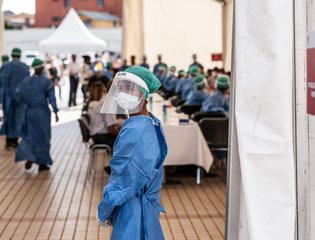The idea of "success" is highly dependent on context and perspective. As an evidence and learning team, we wanted to explore what local communities considered as a "successful" programme and the ways in which this could be measured.
Over the past year, we have been working alongside local consultants to develop evaluation tools that ensure the questions being asked during information gathering are culturally appropriate and conducted in local languages. In June this year we also published a commitment to 'explore local perceptions of programme success…so that our accountability really lies with the people that have been affected by crises'.
During a recent independent monitoring of a heatwave response in Pakistan, our local consultants (GLOW Consultants) spoke with a range of people who had experienced cooling facilities which provided shade and water, and messaging around how to recognise, protect against and act in relation to heatwaves. The community provided highly pragmatic feedback on how we should be measuring success: observe, keep it simple and take time to explore.
1. Observe
The message was very clear: watch what people are doing. If people are using the service you have provided and they seem happy to do so, then you are doing the right thing. If this needs a quantifiable measure, count the number of people using your service.
This intervention represented a unique opportunity to observe how and whether people used the service because – unlike most humanitarian responses – this was a service for everyone rather than a targeted delivery to specific households or individuals. Our evaluation included on-site observation tools for each of the three cooling facilities, however, based on this feedback we would in future like to extend the observation and focus on who as well as how many are using the facility.
"If people are using water from your water stand, come again and again to your water stand, it means you are doing the right thing. If the people's responses are encouraging and assuring, it means the project has been a success. You can measure the success of the intervention by counting the number of people who are visiting your tent."
48 year old male resident of Limji, 35 miles from Sibi, translated from Urdu
"You can see if people are drinking water or throwing it out when they taste it."
55 year old female resident of Village Talli visiting Sibi, translated from Balochi
2. Keep it simple
Many questions put into impact assessments, evaluation tools or post-distribution monitoring forms are complex. They ask, for example, about awareness around feedback mechanisms and compliance to certain standards which are probably not easily translated into local language nor even relevant to those you are speaking to. If people do not understand the question, they will not provide reliable answers.
"You can ask the people whether they liked the water or whether the water was cold and clean?"
37 year old female resident of Sibi, translated from Balochi
The message from those we spoke to in Sibi was to keep our direct questions very simple and relevant to the end-user.
Other ways to increase understanding were proposed, such as using pictures to test the knowledge of practices after a behaviour messaging campaign.
"Maybe you can ask if they liked your place or not. If they say yes, it means they are happy. If they say no, it means they are not happy."
55 year old male who relies on charity, at the bus stop, translated from Siraiki
3. Take time to explore
Affected communities also suggested that it is important to probe on certain issues to better understand if you are providing what they need and if there is anything you can do to improve. The focus should really be on understanding their experience rather than undertaking a tick-boxing exercise.
A key learning for us is that this probing takes time and works better when done in person, and with someone they can trust. When people are allowed to speak freely, their feedback will contain all the answers to how successful the project has been.
"Ask the people, why are they drinking this water and not drinking from other places... if you ask them, then this may help you find out whether you are doing the right things or not."
32 year old male bus driver of the Irri Mirthri route, translated from Sindhi
The way we capture these stories may also need to be revisited. During the pandemic, many evaluators, including the evidence and learning team at Start Network, have relied on remote data collection and interviews conducted by phone. Although these were a necessity due to the travel restrictions during COVID-19, we have recognised that it does have its limitations. In the case of the response in Pakistan, we would have missed the voices of many if we had relied solely on phone interviews.
"It is important you speak with them, and let them speak as much as possible and in the middle, you will find some answer."
50 year old male resident of Sibi, translated from Sindhi
We hope to continue this research on understanding success from a community perspective, and also to take onboard the important lessons from this first study in the way we conduct evaluations. This will include in-person interviews where possible, on-site observations and revision to our evaluation tools. Although most evaluations include qualitative data as supplementary information to their key performance indicators or quantitative metrics of success, they rarely have these as the mainstay of understanding project success. Perhaps this needs to change?
Start Network published a sister blog to this piece – How do crisis-affected communities define a 'successful' humanitarian intervention? – highlighting key findings from interviews with community members affected by the Nyiragongo volcanic eruption in Democratic Republic of the Congo (DRC). They also prepared an infographic summarising their findings on what "success" in early action responses means to affected communities, focusing on how and what organisations should be evaluating.


